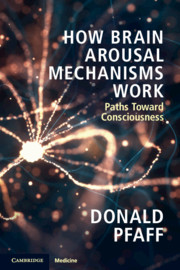
-
Select format
-
- Publisher:
- Cambridge University Press
- Publication date:
- November 2018
- December 2018
- ISBN:
- 9781108377485
- 9781108433334
- Dimensions:
- Weight & Pages:
- Dimensions:
- (234 x 156 mm)
- Weight & Pages:
- 0.3kg, 168 Pages
You may already have access via personal or institutional login
Book description
What are the physical paths towards consciousness? How do humans transition out of deep anesthesia, deep sleep, or traumatic brain injury? This book presents a new argument that expands past theories centered on the cerebral cortex, and instead emphasizes the longitudinally-integrated brainstem systems that are essential to the mechanism of consciousness. The workings of these vertical pathways that 'wake up the brain' are examined in neurobiological and molecular detail. Mirroring the evolution of this system from fish to humans, chapters in the book move from hindbrain to forebrain and from animal brain to human brain, developing the unified approach involved in the brain arousal mechanism. Considering consciousness through an array of neuronal structures, this book provides a new physical explanation of the phenomenon. Written for neurologists, neuroscientists, psychologists and psychiatrists, the book's succinct and readable tone means it is also suitable for readers interested in the workings of the brain.
Contents
Metrics
Full text views
Full text views help Loading metrics...
Loading metrics...
* Views captured on Cambridge Core between #date#. This data will be updated every 24 hours.
Usage data cannot currently be displayed.
Accessibility standard: Unknown
Why this information is here
This section outlines the accessibility features of this content - including support for screen readers, full keyboard navigation and high-contrast display options. This may not be relevant for you.
Accessibility Information
Accessibility compliance for the PDF of this book is currently unknown and may be updated in the future.


